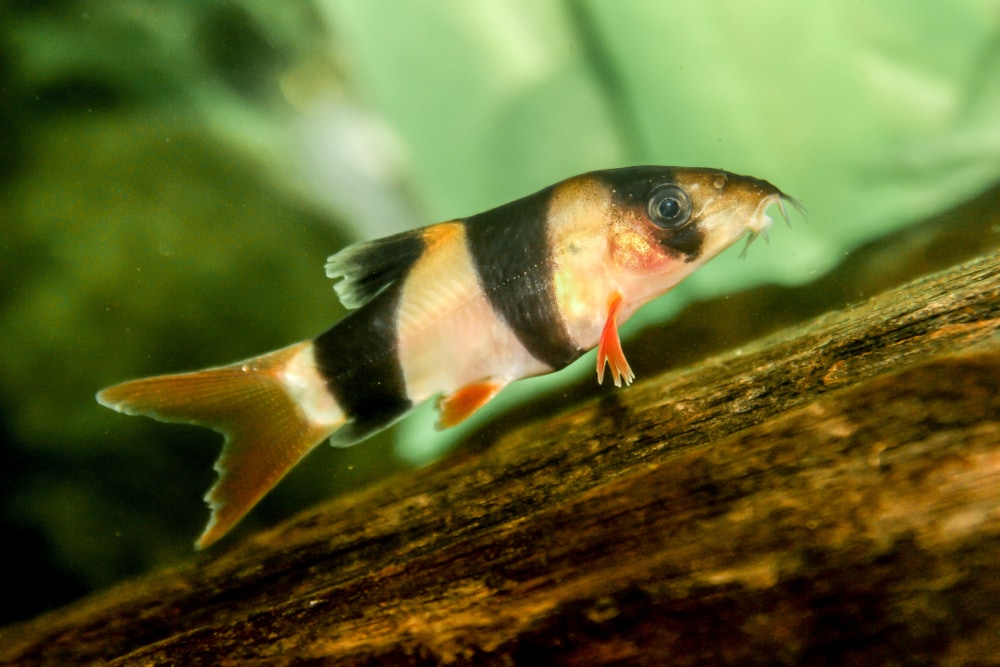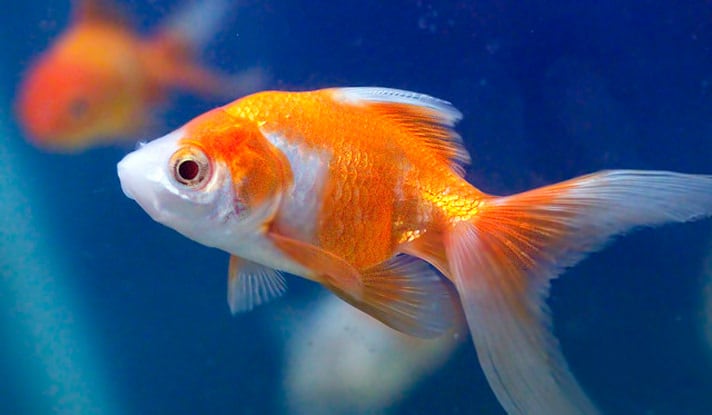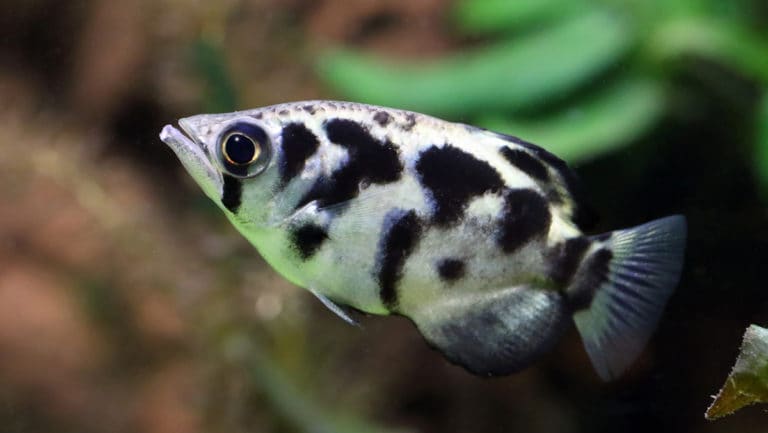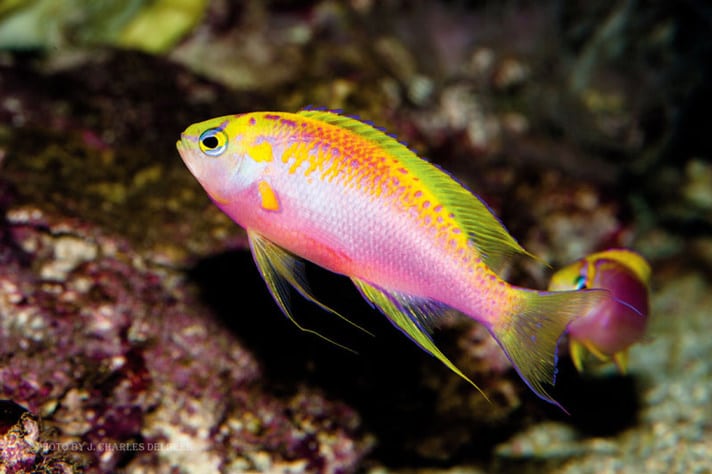Clown loaches are found on the islands of Sumatra and Borneo in the country of Indonesia. They occur in large schools in the rivers and flooded plains of these two islands, where the water is usually moving fairly steadily and is generally well-oxygenated. Their natural water conditions are warm (high 70s to low 80s Fahrenheit) and fairly soft, with a pH from 6.5 to 7.5 (at times, the pH can be outside these values).
The current scientific name for the clown loach is Chromobotia macracanthus, and it is in the family Cobitidae (loaches). Professional ichthyologists spend a great deal of time revising the classification work of previous researchers, and in 2004 the loaches as a group had their turn.
When it comes to ichthyologists and taxonomy (the naming and classification of living things) there tends to be two groups: lumpers and splitters. The lumpers combine together what were separate genera and species. The splitters take an existing genus and split it into more than one either existing or new genera. The splitters were at work with the loaches, and the result for the clown loach is that the fish was assigned the genus Chromobotia, where it is, in fact, the only species. If you would like more details about this taxonomic arcana, or for more about loaches in general, an excellent site on the web is loaches.com.
The Fish
Clown loaches have a typical loach body shape, with a long, pointed nose complete with sensing barbels. The body arches high at the dorsal fin, but is streamlined and clearly built for fast movement. The basic color of the fish is a vibrant orange-yellow, with two wide black V-shaped bands running up and down the sides of the body, one extending completely to the dorsal fin. There is also a third narrow black band that runs vertically through the eye. The tail fin and all of the paired fins are red. Once you see a clown loach, you will never forget it.
In addition to the barbels on the mouth, another interesting characteristic of the clown loach (and many loaches, for that matter) is a sharp spine below each eye. Clown loaches use these spines for defense, and these will also get caught in a net when you are moving the fish from one place to another. If a clown loach is stuck in a net by its eye spines, never try to remove the fish yourself but simply put the net into the water. I have never figured out how they do it, but the fish will quickly free itself.
Most clown loaches sold in the hobby range from 1.5 to 3 inches or so, and at that size the fish are really just babies. Clown loaches in an aquarium will easily grow to 8 inches or larger, and though it takes them a while to get to that size, it’s important that you be able to provide a large enough tank for them as they grow. In the wild, clown loaches live to a ripe old age, and they get incredibly large.
A few years ago, my wife and I took a trip to the Far East, including my attending AquaRama in Singapore, followed by visiting friends of ours who lived in Jakarta, Indonesia. One day, I managed a trip to a fish-holding compound in the jungle two hours outside of Jakarta. It was the Asian equivalent of compounds I have been to in Brazil, except that instead of thousands of cardinal tetras, there were rasboras and clown loaches. As we walked past tank after tank of 2- to 4-inch clown loaches, I asked the proprietor if he had any larger ones. He smiled and ushered us into the next building. There were tanks a little larger than a standard 50 gallon, and in each tank there was a huge clown loach. I mean huge. These fish were large enough that when I put my arm up against the side of the tank, they went from my elbow to the middle of my hand. The fish were 16 to 18 inches long. And they were as thick around as my leg. The colors were incredible, as were the scars and pieces missing from the fins. Clearly these clown loaches were many years old, and they had been through many battles. The best way to cut down on aggression and avoid battles with your own loaches is to provide one or two more hiding places than there are clown loaches.
I asked the owner why we never saw fish this large, and he explained that it was impossible to ship them, even if they were tranquilized and shipped one per box. These fish were a special order for a gentleman from Hong Kong who would come up the river from Jakarta to the compound in his private yacht, where he had a number of large aquariums.
In the Aquarium
Clown loaches are not particularly demanding in terms of pH or hardness. They will tolerate a wide range of pH (from 6.5 to 7.5) and any moderate hardness. Temperatures in the high 70s to low 80s Fahrenheit are needed. They also require excellent water quality. Within their aquarium, there should be a lot of water movement, but they also need quiet places in the tank where the water is moving very little or not at all.
Besides water quality, the most important factor for keeping clown loaches is keeping in mind that they are very active, social fish. So, they need to be kept in groups of at least five fish. This can be a problem. First, all clown loaches are fairly expensive, and second, they do grow quite large — eventually a group of five will require a 70-gallon tank or larger.
It should now be obvious that the tank for clown loaches needs to be large. It should also be densely planted on at least one side of the tank because these fish like to hang out in the shadows. Driftwood and rocks are a necessity in a clown loach tank. The more hiding places you give these fish, the more secure they will feel, and therefore the more time they will spend in the open. One interesting thing to note about clown loaches is that they will often school with tiger barbs, especially if the two fish are close to the same size.
Feeding and Breeding
When it comes to feeding, clown loaches are true omnivores — they will eat just about anything and everything. Their diet should include a good staple fish food (or a few different ones) and small worms in some form. They absolutely relish live blackworms and will also consume frozen blackworms, bloodworms or Tubifex worms. In addition, they require a fair amount of plant matter in their diet. The easiest way to meet this requirement for vegetable matter is to give them slices of zucchini, squash or potato that have been nuked in a microwave for 20 seconds or so. They will also do well on Spirulina wafers or any of the algae sheets that are available for marine algae feeders. If you provide clown loaches with any soft-leaved, fast-growing live plants, such as Cabomba or Egeria/Anacharis, they will nibble on them constantly.
Breeding clown loaches is still the pinnacle never reached (at least within the hobby). Although there are a number of aquarist tales of “I know a guy who knows a guy who bred clown loaches,” I have yet to see any actual documented cases of hobbyists spawning these fish. Given the size of the ones I saw in Indonesia, it may simply be that in a fish tank, it’s not possible for them to grow large enough.
The Far East — Indonesia in particular — is where all of the clown loaches for the hobby come from, and there is a definite seasonality to the fish. It used to be that when the “first crop” of clown loaches came around, the only fish available were small, about an inch or so. Then the available fish got larger as the year progressed. Now it seems there are “brokers” who pretty much control the clown loach business in that region, and I’m really not sure how and where they are getting the fish.
One reliable source (the guy who sells me trans-shipped Far East fish) says that clown loaches are “farmed” in the wild, which means that people have large sections of the wild where they monitor the spawning of the fish. Babies are taken in huge numbers and grown out in large ponds, much as they do with Asian arowanas. This makes sense, explaining why clown loaches are usually available to the industry in progressively larger sizes. I’ve talked with a fish farmer in Tampa, Florida, about commercial spawning of clown loaches, and he tells me that they have tried to do it in Florida with no success. They regularly spawn red-tailed and rainbow sharks using hormone injections, but apparently this has never been successful with clown loaches.
Plants and Snails
Clown loaches have an excellent reputation for controlling nuisance snails — and they will, in fact, easily keep any population of snails in check. They are not, however, the best fish to use for this purpose because they need to be in groups of five or more, and they grow fairly large, making them unsuitable for snail patrol in most setups. I have had the best luck for snail duty with either a yoyo (Botia almorhae) or red-tailed (B. rubripinnis) botia. These fish do just fine on their own, and they only grow to about 4 to 5 inches. I had one red-tailed botia that I moved around from tank to tank simply by taking the 6-inch-long piece of 1.5-inch PVC it lived in, so it could do snail patrol in all my tanks.
I should also mention that while they like a densely planted portion of their tank, clown loaches can be rough on some plants. A few years ago, I had the privilege of having Claus Christensen of Tropica Plants in Denmark stay at my house for a few days. When Claus first walked into my house, he looked at the planted 150-gallon tank I have right off the kitchen. Although the clown loaches were not visible, he said, “Oh, I see you have clown loaches.” I admitted I did have a school of them in that tank and asked him how he could tell. He went over and pointed to the many holes in the Amazon sword plants in the tank, and explained that clown loaches typically were responsible for that type of damage on those plants.
From that experience, I learned that clown loaches can be quite damaging on soft-leaved rosette plants, such as Amazon swords (Echinodorus) and crypts (Cryptocoryne). The best plants to keep with clown loaches are tough-leaved ones, such as Anubias and Java fern. Stem plants like Hygrophila and Ludwigia also will usually stay ahead of any damage that clown loaches may do to them.
The Ich Problem
Clown loaches have one problem: They are susceptible to ich and can be difficult to treat once they have it. Because they are scaleless fish, they don’t do well with the typical ich medications containing formalin and malachite green, or medications based on copper.
My friend Brian Aukes of National Fish Pharmaceuticals educated me on this problem a few years ago. Brian pointed out that there was a new strain of ich going around that he called “Far East Super Ich” that did not respond to either of the two normal treatments. He had experimented with various medications and found that quinine would cure this malady. In my wholesale fish business, I often had problems with clown loaches coming down with ich — to the point that I no longer carried them. Brian told me to use quinine and I would not have any problems. He was absolutely correct. I now always have as many different sizes of clown loaches as I can buy in stock all the time, and simply by treating them with quinine, I have completely eliminated any problems of ich with these fish.
I strongly recommend two things to controlling ich in clown loaches. First, make sure you purchase clown loaches that have been in your local fish store for at least a week. If they are going to come down with ich, they will do so within that span of time. Second, make sure you use a quarantine tank before you introduce any clown loaches into your main display aquariums.
A quarantine tank can be a 10- or 15-gallon fish aquarium with a sponge filter, heater and cover. Any clown loaches you purchase should be kept in this quarantine tank for at least two weeks before introducing them into the main tank. (Actually, quarantine tanks should be used for all fish.) To be safe, I recommend you treat new clown loaches in the quarantine tank with one or two doses of quinine.
The “Loach Circle”
I’ve noted that these fish are active — and I wasn’t exaggerating. They are constantly chasing each other around the tank and often will do the “loach circle,” in which they go around in a circle on one side of the glass of their tank.
Clown loaches are known to eat snails, but they should not be purchased for this reason. Because they are schooling fish, they need to be kept in groups, and their large size doesn’t make them the best candidate for most tanks.
Clown loaches are beautiful, active, long-lived fish that make a great display in any tank. They need to be kept warm, and live in groups of five or more. Because they become so large, you must be prepared to move them into a larger tank as they grow, eventually providing at least 5 to 10 gallons for each adult. Quarantine any new fish before introducing it to the main tank, and you will enjoy keeping these fish for many years.
David A. Lass has owned and operated retail pet stores and a wholesale fish import/distribution business.
Featured Image: Via Shutterstock
Share:









